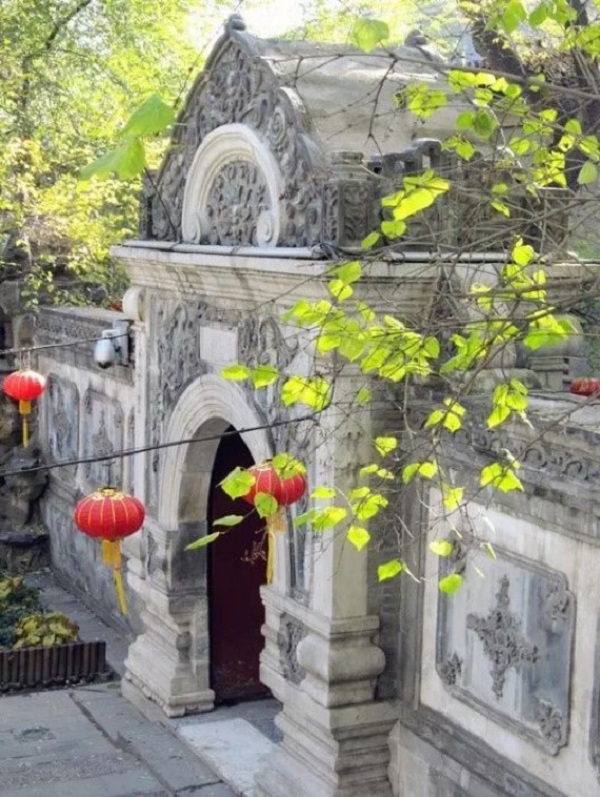
Early in the Ming Dynasty (1368-1644), people started to build Western-style buildings in China. During the Qianlong reign (r. 1736-1795) in the Qing Dynasty (1644-1911), Western-style architecture came into being in Yuanmingyuan (the Old Summer Palace), a former royal resort in Beijing that was burned down by invading British and French military forces in 1860 during the Second Opium War (1856-1860).
These Western-style buildings integrated architectural culture of both China and the West, forming unique features amid the cultural exchanges between two sides in the 17th and 18th centuries. Western-style gates were leading representatives of the architectural hybrids at that time.

The photo shows a Western-style gate in a scroll painting by Giuseppe Castiglione (1688-1766, whose Chinese name was Lang Shining), a Qing imperial court painter from Italy. There were 12 such specific paintings, which portray the happy time spent by Emperor Yongzheng (r. 1723-1735) of the Qing Dynasty with his children in the Old Summer Palace.
Western-style gates in the Qing Dynasty
Architectural designs from the West were adopted in the building of Western-style gates in China during the Qing Dynasty. Instead of being closely associated with doors in the art of traditional Chinese architecture, these Western-style gates were actually independent buildings loaded with concrete functions in traditional Chinese architectural complex.
For instance, Tian'anmen (the Gate of Heavenly Peace) and Wumen (the Meridian Gate) were unattached giant buildings in the Palace Museum, also known as the Forbidden City. All courtyards and some independent buildings had their own doors. The houses of both rich and common peoples were no exception. Sometimes, there were three sets of doors in the house of rich families. These doors served to create a private space for their owners.
During the Qing Dynasty, Western-style gates shared the same functions as festooned gates and decorative archways in the culture of traditional Chinese architecture. A door is generally situated in the middle of traditional Chinese dwellings, dividing interior spaces into more rooms.
However, Western-style gates in China downplayed the concrete functions of doors and given priority to its decorative utility as the Arc de Triomphe of France does. Therefore, it is natural to stress the decorative functions of Western-style gates when they were used in China. The combination of Chinese and Western architectural characteristics in the building has defined its decorative functions in the art of ancient Chinese gardens.

Western-style gate in Prince Kung's Palace Museum
Remaining Western-style gates in Beijing
The section of Western-style buildings in the Old Summer Palace is a hub of Western-style gates built in the royal gardens of the Qing Dynasty. The culture of traditional Chinese architecture was fully reflected in the division of gardening space. Some unattached Western-style gates such as those in Faxian Hill were built to mark the beginning and end of limited space.
Meanwhile, there were some Western-style gates built in courtyard walls and acted as an entrance. The southern gates of both the Throne for Observing the Grand Fountain (Guan shuifa) and Flower Labyrinth (Wanhua zhen) belonged to the latter type of Western-style gates in the Old Summer Palace. Many experts agree that they were incorporated with baroque-style traditions.
However, these exquisite buildings were burnt to ashes by invading British and French army in 1860.

A photo of the southern gate of Flower Labyrinth in the Old Summer Palace

A photo of the southern gate of the Throne for Observing the Grand Fountain (Guan shuifa) in the Old Summer Palace
Western-style gates, which remain standing in Beijing, can be found in the Temple of Longevity, former Yangyun Residence of Royal Concubines in the Summer Palace and Prince Kung's Mansion.

Western-style Gate in the Temple of Longevity

Western-style Gate in former Yangyun Residence of Royal Concubines

Western-style Gate in Prince Kung's Palace
Western-style Gate in Prince Kung's Palace
The Western-style Gate in Prince Kung's Palace enjoys more importance than others left intact in Beijing. It is the principal entrance of the garden of Prince Kung's Palace. It was there even before Prince Kung was awarded the mansion by Emperor Xianfeng (r. 1851-1861) in 1851. It isn't still known when it was actually built.
However, He Shen (1750-1799), former owner of the mansion and a top official during the reign of Emperor Qianlong (r. 1736-1795), was in charge of building the Old Summer Palace. Therefore, there must be some connections between the Western-style gates in Prince Kung's Palace and the Old Summer Palace. Moreover, it is rare to find a Rococo-style stone gate in Chinese private gardens.

Western-style Gate in Prince Kung's Palace Museum
It is very easy to discern the similarities between the Western-style gates in Prince Kung's Palace and those in the Old Summer Palace. There are more Chinese architectural elements in the Western-style Gate in Prince Kung's Palace. However, the part above the cornice seems to be thoroughly different from the art of traditional Chinese architecture.

Western-style Gate in Prince Kung's Palace
Compared with the Western-style gates in the Old Summer Palace, the version in Prince Kung's Palace became more mature in the integration of traditional Chinese architectural art. The stone inscriptions "Jing Han Tai Gu" and "Xiu Yi Heng Chun" reflect the psychological state that Prince Kung aspired to be. By combining the concept "Jing" (serene) and "Gu" (ancient), the gate is integrated with the natural scenes inside the garden, reflecting the sense of traditional Chinese culture and Taoism.

A stone inscription of "Jing Han Tai Gu" on the Western-style Gate in Prince Kung's Palace
Since the late period of the Qing Dynasty, the Western-style gates had become widely accepted by ordinary people in China until they totally found no place in any traditional Chinese architecture during the period of the Republic of China (1912-1949).
As a classical architectural representative in Chinese history, the Western-style Gate in Prince Kung's Palace still helps people learn more about the glorious history of Chinese architecture.